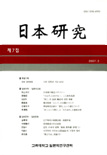- 영문명
- 발행기관
- 고려대학교 글로벌일본연구원
- 저자명
- 安志英
- 간행물 정보
- 『일본연구』第13輯, 247~266쪽, 전체 20쪽
- 주제분류
- 인문학 > 문학
- 파일형태
- 발행일자
- 2010.02.28
5,200원
구매일시로부터 72시간 이내에 다운로드 가능합니다.
이 학술논문 정보는 (주)교보문고와 각 발행기관 사이에 저작물 이용 계약이 체결된 것으로, 교보문고를 통해 제공되고 있습니다.

국문 초록
영문 초록
The purpose of this thesis is to analyze the origin of the compound particles 「tokoroga」 and 「tokorode」 and follow the integration of the compound particles in language over time. The following information was derived as a result of the analysis
(1) The compound particle 「tokoroga」 seems to have originated during the Meiji periods and was initially used more commonly as a contrary conjunction rather than a conditional conjunction because the contrary particle 「ga」 had a stronger effect than 「tokoro」. With passage of time, 「tokoro」 gradually became more commonly used as a conditional conjunction due to the strong linkage of the word to scenic presentations. As a result of language development, 「tokoro」has become a compound particle in common language use today.
(2) The first known appearance of 「tokoroga」 in Japanese literature was in the year gyokuzinsyou 1563 and it was originally used as a contrary conjunction. However, it was not used ever again in the Kamigata dialects until the Edo periods.
(3) During the Meiji periods, as the new compound particles 「-temitatokoroga」 and 「-nisitatokoroga」 began to be used, 「tokoroga」 became more widely used as a contrary conjunction.
(4) The form of the compound particle 「tokorode」 transformed over time from 「tokoronite」 to 「attributive + tokorode」 to its final form 「tatokorode」 during the 16th century.
(5) The first known appearance of 「tokorode」 in Japanese literature Tyukaz -yakubokusisyou was approximately in the year 1520 and it was originally used as a conditional conjunction.
(6) The compound particle 「tokorode」 is commonly used as a conditional conjunction in the meaning of fact. However, there is some evidence that it was also used as a conditional conjunction in the meaning of supposition in the Kamigata dialect.
(7) During the Meiji periods, new compound particles emerged in addition to 「to korode」, including 「-tositatokorode」, 「-temitatokorode」 and 「-nisitatokorode」. The compound particle 「tokorode」 was considered a conditional conjunction of supposi tion as a result of the usage of adverbs such as 「tatoi」, 「yoshinba」, 「karini」, and 「yosi」.
목차
Abstract
1.はじめに
2.調査資料及び考察方法
3.各作品に見られる 「ところが」の樣相
4.各作品に見られる 「ところで」の樣相
5.おわりに
參考文獻
키워드
해당간행물 수록 논문
- 日本語 名詞表現을 통해 본 名詞의 動詞性
- 문학의 콘텐츠화 전략 연구
- 『日本硏究』 投稿規定 외
- 대중문학 형성기에 있어서의 아쿠타가와 류노스케(芥川龍之介)의 문학관
- 근현대에 있어서의 접사적 자음형태소의 변천의 일례
- 청일전쟁기, 열강과 일본의 중국침탈
- 아키나리(秋成)의 문학관
- 식민지 조선에서의 도한일본여성의 현실
- 古代 女性天皇論
- 재일한국인·조선인의 정체성에 관한 연구
- 한일 안보협력의 새로운 모색
- 김수미 저 『겐지모노가타리 공간표현론』
- 특별기고 집필자 프로필
- 『두 가지 색도(色道)』의 시대
- 에도문학의 다양성
- 재일 한국인의 의식에 관한 연구
- 근세 전기의 괴이소설(怪異小說)과 웃음(笑い)
- 미쓰모토 겐 저 『가나조시(仮名草子)의 모노가타리(物語)』
- 廣開土王碑文을 통한 『日本書紀』 神功, 應神紀의 분석
- 일본연구센터 동정(2008.9.1∼2009.2.28) 외
- 複合辞に関する史的硏究
- 모노가타리 집(物語集)으로서의 『쓰즈라부미(藤루冊子)』
- 일본대학의 국제화를 위한 외국인 교원임용
- 아키나리(秋成)의 ‘거짓(僞り)’의 문제
참고문헌
관련논문
인문학 > 문학분야 BEST
- 근대 문학과 목격의 서사 : 이상 「날개」 연구
- 한자의 문화적 정체성과 현대 사회에서의 재해석 - 한·중·일 삼국을 중심으로
- 텍스트 마이닝과 네트워크 분석을 활용한 『논어(論語)』 연구 동향 분석 - 2000-2023년 국내 학술논문을 중심으로
인문학 > 문학분야 NEW
- <몽옥쌍봉연록-곽장양문록> 연작의 곽분양 수용 양상과 그 의미
- 강을생본 <허웅애기본풀이>에 나타난 사별 애도 과정과 의미 - 영화 <원더랜드>(2024) 속 모녀 관계와의 비교를 겸하여
- <세경본풀이>의 통사론적 규칙과 서사 의미론
최근 이용한 논문
교보eBook 첫 방문을 환영 합니다!

신규가입 혜택 지급이 완료 되었습니다.
바로 사용 가능한 교보e캐시 1,000원 (유효기간 7일)
지금 바로 교보eBook의 다양한 콘텐츠를 이용해 보세요!



